Back to the Zoo
Well, it has been more than a year since I went to the Indianapolis Zoo. Some of you may remember my post last year titled Some Lighter Elements, in which a few of the Zoo's more talkative denizens really let their hair down and expressed themselves! ;) In this latest expeditionary adventure, the beasts from far afield were a bit more reticent about sharing their true feelings with me (I think they were somewhat embarrassed to have their unvarnished thoughts published last time around!), however, they were kind enough to pose for a few pictures by your intrepid host. :)
First up for your viewing pleasure is a mother elephant and her one year old baby. Interestingly, in the few weeks since my Zoo visit, another elephant gave birth! I have seen the new baby on the local TV news. She is so tiny (well, its relative) and very cute! When she was born, she weighed more than 200 pounds. Now that's quite a bouncing baby! :)

Here is a picture of the same one year old elephant with some of his keepers who were mucking out (just use your imagination, big big piles of...) the enclosure. What a good baby running over to help clean up! :)

Well, just like last year, I stopped by to see how the giraffes were doing. These two were happily munching on some food items placed in a bin up in their tree.

This may be the world's laziest rhino! When I was a kid, I was fascinated by rhinos. Many kids have a piggy bank, but I had a rhinoceros bank! Whenever I had the chance to play with clay in school, I would make a rhino. I don't remember why I liked rhinos so much, maybe I just thought their horns looked cool.
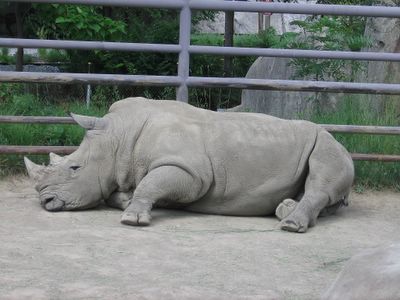
Here are some cute little guys called meerkats, who hale from Africa's Kalahari Desert. They are a relatively new exhibit at the Zoo. They are housed in a very neat building with a geodesic glass dome. Inside the building are all sorts of creatures that inhabit various desert environments around the world like lizards, tortoises (I took a few reptile pics, but they weren't that exciting), and various birds. There are actually about a dozen meerkats in the exhibit. They are very social animals that live in large family units. They are somewhat similar to prairie dogs (large ground squirrels from the American West) in their habit of digging large underground homes. They seem so intelligent when they look right at you with their big eyes, and boy are they curious! If all humans, apes, and monkeys were to somehow vanish from the face of the Earth (not an impossibility, in my opinion, I am sorry to say), I can really see meerkats taking over after a few million years! If you get the cable channel Animal Planet, there is a fun and interesting show called Meerkat Manor which follows the lives of a large family group. It is rather like an animal soap opera! :)
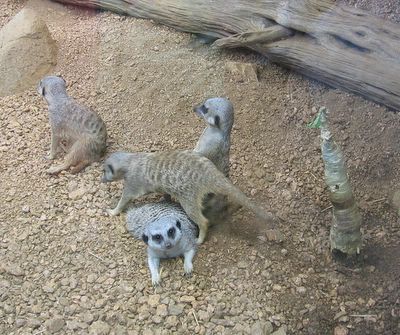
Here are some really colorful and quite tame parrots. They were just about eating out of people's hands, as you can see! Parrots are probably the smartest of all birds. I saw a program about an African Gray Parrot that has learned about 300 words and can apparently speak in complete sentences! As I recall, his trainer is a research psychologist. Her work is really opening up a new frontier in the understanding of intelligence! Maybe I was a bit hasty in predicting that meerkats will inherit the Earth. ;)
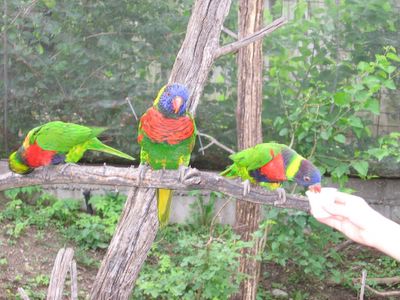
Ah, now this may well be one of the best photographs that I have ever taken! Just as I did last year, I also stopped by the Indianapolis Botanic Gardens, which is next to the Zoo. Every year, they have an indoor butterfly exhibit for several months. This butterfly is a member of a group called blue morphos. They live in Central and South America. This is a very large butterfly, having a wing span of about six inches. It flitted right past my face, actually startling me! Then it landed on a nearby hanging basket of ferns. I just walked up, lifted my digital camera above my head, and snapped a few quick pics. This one was the best. Usually, when these particular butterflies land, they fold their wings up so that only the underside of the wings are visible. The undersides are a rather drab brown with small eye spots. I think they are colored to resemble dead leaves to help the butterfly hide in trees. However, for some reason, this butterfly decided to show its upper wings in their full iridescent glory!

The next two pictures were not taken at the Zoo or the Gardens, but rather near where I live. The subject of the photos is probably the most famous of North American butterflies, the Monarch. These butterflies are best known for their epic migration (some fly more than 2000 miles!) which occurs every year in the Fall. All the Monarch butterflies, from as far north as parts of Canada, south to Florida, and west to California, migrate to a few isolated places in the mountains of central Mexico (some over winter in California: see update below). There, as many as half a billion Monarchs will spend the winter, alive but in a semi-torpid state, occasionally rousing from their rest to flit about. The trees are literally carpeted with butterflies! Unfortunately, in recent years, these mountain sanctuaries have come under attack by logging pirates who have been illegally cutting the trees. Hopefully, these places will be better protected in the future! When the warming of Spring comes, the Monarchs once again start to fly northward. Throughout the Spring and Summer months, there may be as many as five generations of Monarchs that spread out north, east, and west, until they reach the limits of the continental U.S. and southern Canada. Then, once again, the cycle repeats when the last generation of the year instinctively knows to fly all the way back to Mexico. The Monarch is one of the true wonders of nature! This particular one is apparently stocking up on nectar to fuel the next leg of its long journey.
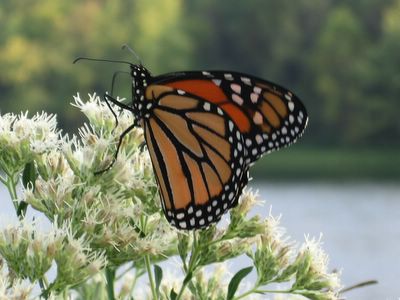
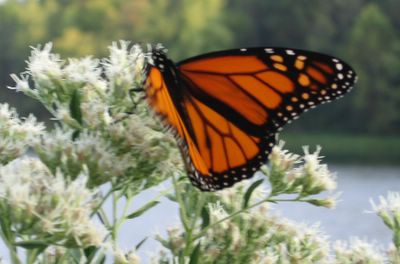
Here is a link to a wonderful site showing pictures of the Monarch butterfly's complete lifecycle from egg, caterpillar, chrysalis (the fascinating metamorphic stage between caterpillar and butterfly), and adult. These are really terrific pictures, so please check them out! If you would like to learn more about the Monarch migration and the threats to their conservation in Mexico, this news article from a few years ago is very informative.
Monarch Update: My friend Jarvenpa has just taught me that Monarch butterflies also have winter homes in California. Here is a link to the State Park at Santa Cruz, CA where some of the Monarchs spend the winter. Apparently, The Monarchs west of the Rocky Mountains spend the winter in California, while those east of the Rockies fly to Mexico. I found a Wikipedia article that taught me even more about Monarchs. This article said that Monarchs live in Bermuda, Spain, and Portugal, and are sometimes seen in England. Also, they were introduced to Australia and New Zealand in the 1800's. Thanks Jarvenpa!
Finally, a 15 year old blogger from Rasht, Iran commented recently to my previous post. He is apparently a very accomplished journalist, and I was impressed with his blog. So, if you would like to give this young man some encouragement, why don't you check out Kourosh's blog. He surprised me by saying that my blog is being filtered in Iran. Well, I guess that I have finally "arrived"! ;)
First up for your viewing pleasure is a mother elephant and her one year old baby. Interestingly, in the few weeks since my Zoo visit, another elephant gave birth! I have seen the new baby on the local TV news. She is so tiny (well, its relative) and very cute! When she was born, she weighed more than 200 pounds. Now that's quite a bouncing baby! :)

Here is a picture of the same one year old elephant with some of his keepers who were mucking out (just use your imagination, big big piles of...) the enclosure. What a good baby running over to help clean up! :)

Well, just like last year, I stopped by to see how the giraffes were doing. These two were happily munching on some food items placed in a bin up in their tree.

This may be the world's laziest rhino! When I was a kid, I was fascinated by rhinos. Many kids have a piggy bank, but I had a rhinoceros bank! Whenever I had the chance to play with clay in school, I would make a rhino. I don't remember why I liked rhinos so much, maybe I just thought their horns looked cool.

Here are some cute little guys called meerkats, who hale from Africa's Kalahari Desert. They are a relatively new exhibit at the Zoo. They are housed in a very neat building with a geodesic glass dome. Inside the building are all sorts of creatures that inhabit various desert environments around the world like lizards, tortoises (I took a few reptile pics, but they weren't that exciting), and various birds. There are actually about a dozen meerkats in the exhibit. They are very social animals that live in large family units. They are somewhat similar to prairie dogs (large ground squirrels from the American West) in their habit of digging large underground homes. They seem so intelligent when they look right at you with their big eyes, and boy are they curious! If all humans, apes, and monkeys were to somehow vanish from the face of the Earth (not an impossibility, in my opinion, I am sorry to say), I can really see meerkats taking over after a few million years! If you get the cable channel Animal Planet, there is a fun and interesting show called Meerkat Manor which follows the lives of a large family group. It is rather like an animal soap opera! :)

Here are some really colorful and quite tame parrots. They were just about eating out of people's hands, as you can see! Parrots are probably the smartest of all birds. I saw a program about an African Gray Parrot that has learned about 300 words and can apparently speak in complete sentences! As I recall, his trainer is a research psychologist. Her work is really opening up a new frontier in the understanding of intelligence! Maybe I was a bit hasty in predicting that meerkats will inherit the Earth. ;)

Ah, now this may well be one of the best photographs that I have ever taken! Just as I did last year, I also stopped by the Indianapolis Botanic Gardens, which is next to the Zoo. Every year, they have an indoor butterfly exhibit for several months. This butterfly is a member of a group called blue morphos. They live in Central and South America. This is a very large butterfly, having a wing span of about six inches. It flitted right past my face, actually startling me! Then it landed on a nearby hanging basket of ferns. I just walked up, lifted my digital camera above my head, and snapped a few quick pics. This one was the best. Usually, when these particular butterflies land, they fold their wings up so that only the underside of the wings are visible. The undersides are a rather drab brown with small eye spots. I think they are colored to resemble dead leaves to help the butterfly hide in trees. However, for some reason, this butterfly decided to show its upper wings in their full iridescent glory!

The next two pictures were not taken at the Zoo or the Gardens, but rather near where I live. The subject of the photos is probably the most famous of North American butterflies, the Monarch. These butterflies are best known for their epic migration (some fly more than 2000 miles!) which occurs every year in the Fall. All the Monarch butterflies, from as far north as parts of Canada, south to Florida, and west to California, migrate to a few isolated places in the mountains of central Mexico (some over winter in California: see update below). There, as many as half a billion Monarchs will spend the winter, alive but in a semi-torpid state, occasionally rousing from their rest to flit about. The trees are literally carpeted with butterflies! Unfortunately, in recent years, these mountain sanctuaries have come under attack by logging pirates who have been illegally cutting the trees. Hopefully, these places will be better protected in the future! When the warming of Spring comes, the Monarchs once again start to fly northward. Throughout the Spring and Summer months, there may be as many as five generations of Monarchs that spread out north, east, and west, until they reach the limits of the continental U.S. and southern Canada. Then, once again, the cycle repeats when the last generation of the year instinctively knows to fly all the way back to Mexico. The Monarch is one of the true wonders of nature! This particular one is apparently stocking up on nectar to fuel the next leg of its long journey.


Here is a link to a wonderful site showing pictures of the Monarch butterfly's complete lifecycle from egg, caterpillar, chrysalis (the fascinating metamorphic stage between caterpillar and butterfly), and adult. These are really terrific pictures, so please check them out! If you would like to learn more about the Monarch migration and the threats to their conservation in Mexico, this news article from a few years ago is very informative.
Monarch Update: My friend Jarvenpa has just taught me that Monarch butterflies also have winter homes in California. Here is a link to the State Park at Santa Cruz, CA where some of the Monarchs spend the winter. Apparently, The Monarchs west of the Rocky Mountains spend the winter in California, while those east of the Rockies fly to Mexico. I found a Wikipedia article that taught me even more about Monarchs. This article said that Monarchs live in Bermuda, Spain, and Portugal, and are sometimes seen in England. Also, they were introduced to Australia and New Zealand in the 1800's. Thanks Jarvenpa!
Finally, a 15 year old blogger from Rasht, Iran commented recently to my previous post. He is apparently a very accomplished journalist, and I was impressed with his blog. So, if you would like to give this young man some encouragement, why don't you check out Kourosh's blog. He surprised me by saying that my blog is being filtered in Iran. Well, I guess that I have finally "arrived"! ;)

